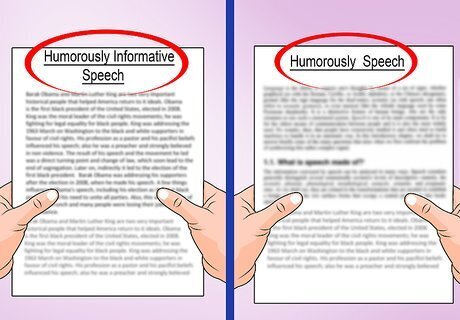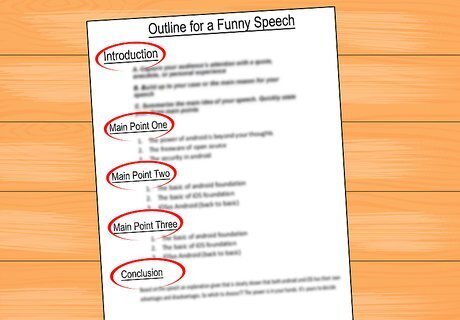
views
X
Research source
Choosing Your Topic

Find a topic. When choosing it, remember that the quality of your speech doesn’t necessarily rely on the topic but on what you have to say and how you say it. Think about -- and then make -- a list of things you know a lot about or enjoy talking about. Single out the topics you’re knowledgeable about but also know you can be funny about. This might rule out topics that are hard to joke about, like poverty, domestic violence, etc. Use this list (in combination with the next step) to select a potential topic.

Consider your audience. Think about who you’ll speak. Of the list of things you wrote down in Step 1, what are the topics that would appeal to your audience? Some questions to consider: What’s the general age of your audience? What do your audience members have in common? What kind of speech are they expecting to hear? What kind of humor are they likely to appreciate?

Determine whether the speech should be humorously informative or just humorous. A humorously informative speech will still be primarily about conveying information to the audience while also making them laugh. A strictly humorous speech, on the other hand, will primarily aim to make the audience laugh -- whether or not it’s particularly informative isn’t the main concern. If you’re writing a speech whose primary goal is to convey information or ideas, you’ll want to integrate humor while focussing on the ideas you want to convey. So draft the informative parts of your speech first, then integrate jokes and humor. If you’re writing a speech whose primary goal is humor -- perhaps a satire or parody -- then you’ll want the humor center stage from the beginning. Choose a topic that lends itself to your sense of humor as well as to what the audience is likely to find amusing.
Writing Your Speech

Decide your “big idea.” Once you have your topic, you’ll next need to think about the main point of your speech. Decide what main message you want to get across. Remember to choose a specific topic -- if your main idea/topic is too broad, you won’t do it justice in a relatively short speech. Choose something that you can describe in reasonable depth in the time allotted. For example, if you’re writing a humorously informative speech about early American cinema, your main idea might be, “the advent of sound in film hurt rather than helped the medium by detracting from its visual potential”. This is specific enough not to be overwhelming while still leaving you room to develop substantial supporting points. If, on the other hand, you’re writing a satirical speech, say, about reality television, your main idea might be, “nothing has contributed more to the cultural and intellectual richness of American society than reality television”. Larry David Larry David, Comedian Mine your own unique experiences for inspiration. "It's always good to take something that's happened in your life and make something of it comedically."

Decide your main points. Use your favorite brainstorming technique to come up with potential significant points you can discuss to support your main idea. Write down your main idea. Below it, write out everything that comes to mind when you think about that idea. Use whatever visual or textual brainstorming method you prefer (eg, clustering, listing, freewriting, etc.). Eliminate anything that’s too far away from the topic, that you don’t feel comfortable discussing, or that would require too much time and depth to cover. Select your strongest points and decide which ones to include.

Outline your speech. Flesh out how you’re going to talk about your main points to support your “big idea.” A commonly used outline for speeches resembles the following: I. Introduction (where you state your main topic and the points you’ll make) II. Main point one III. Main point two IV. Main point three V. Conclusion (in which you sum up the main points, re-state your main idea, and issue a call to action from the audience, if appropriate)

Begin with a “hook.” Start your speech off in a way designed to capture the audience’s attention and pique their interest. Because you’re writing a humorous speech, this is an ideal time to work in a bit of humor. Effective hooks include humorous personal anecdotes, surprising or entertaining examples, or direct questions to the audience that invite their participation and give them a chance to laugh at themselves. For example, if you’re writing a speech about studying abroad, you might start by asking if anyone has ever wished they had an accent or intentionally faked one. You can then suggest they do it right and live somewhere they’ll actually have a legitimate accent.

Write simply and clearly. We only absorb some 25 percent of what we learn by hearing it. Because your audience will hear rather than read your speech, be sure your diction is clear and your language simple and direct. Err on the side of clarity over style, subtlety or artistry. Unlike a written piece, a speech is as much about delivery as it is about content, and the audience will be less attuned to the intricacies of sentence construction and more attuned to your overall message and the expressions as you give it. Avoid overly long and complicated sentences. Long and difficult sentences will be hard to follow. Simplify your point and/or break complicated sentences into smaller, more easily digested ideas.

Use vivid and specific adjectives. Clear and direct sentence structure is enhanced by your choice of descriptive words which should be as vivid as possible. The more apt and descriptive a word, the fewer needed to communicate the same idea. For example, a word like “incendiary” is both more vivid, specific, and aurally interesting than a word such as “controversial”. “Incendiary” communicates the idea of something explosively provocative, while “controversial” is a more general term for something that generates disagreement.
Incorporating Humor

Work humor into the text, once you have the foundation of your speech. This part is important -- but it can also be tricky if you aren’t careful. Consider generational differences with humor -- use references and jokes that address topical issues for that age group. For example, if you’re writing a speech about volunteering to an audience of high school students, relate the information in your speech to specific things and events relevant to teenagers. You might make a joke about volunteering versus staying home and trying to be Jimi Hendrix on Guitar Hero. Or you might pick a guitarist more recent than Jimi! Know what the audience members have in common. Use it when writing jokes oriented around those shared elements, which are more likely to hold the audience’s attention. Doing so is invariably a crowd-pleaser. For example, if you’re addressing teachers, you might make a humorous reference to students’ most bizarre homework excuses. Situational and observational humor that’s tailored to its audience is often particularly effective.

Get inspired. It’s much easier to write with humor when you’re in a humorous mood, so before sitting down to write something funny, get inspired by the things you find amusing. Watch your favorite funny movie, television show, or comedian. Read works by your favorite humorous writers. Don’t hesitate to take cues from their delivery -- learn from what they do to make a joke successful. (But don’t plagiarize!) Pay attention when you make people around you laugh. Note the things you do or say that make people laugh and how you do it. If, for example, your friends can’t stop laughing when you humorously re-enact stressful situations or conversations, try to incorporate similar elements into your speech.

Keep the humor responsible. Don’t go for cheap laughs at the expense of particular people or groups. Targeting particular people or groups is not only inconsiderate, it can alienate members of your audience. Avoid jokes that are made at the expense of one side or another in a contentious issue, like jokes about one side of a political or religious debate. Don’t make jokes about experiences you don’t understand. A good general rule is to write what you know. So if you, for example, have a learning disability, you might make a joke about the difficulties of dealing with standardized tests. But if you don’t have a learning disability, don’t make jokes about those who do -- you don’t share their specific experience, so you may unintentionally be making jokes about sensitive, potentially even hurtful, issues. Also take the taste level of your audience into consideration when deciding if a joke is going to be offensive. If you’re giving a speech to a room of educated adults, you’ll probably want to avoid overly bawdy or sexual humor.

Keep the humor relevant. Don’t just drop a joke into your speech for the sake of having a joke to tell. If it isn’t clearly connected and relevant to your speech, it will only confuse the audience and likely fall flat. The more relevant your jokes are to the specific matter at hand, the more likely they are to be successful with and entertaining.

Be self-deprecating. Audiences tend to respond well to speakers who are gently self-deprecating -- it allows them the chance to feel more comfortable with you and with the idea of laughing with you. But don’t go to extremes of self-loathing, as that will have the opposite effect. The audience won’t know whether to laugh or what you’re trying to accomplish.

Maintain focus. Don’t lose sight of the ultimate purpose or main idea. Remember just what information it is you need to convey and ensure that it’s clear. Don't let the humor become distracting. Humor can be a great tool for enhancing the information you’re conveying, as long as it doesn’t become a larger focus than the informative content itself.

Edit and revise -- multiple times. Getting your message across in just the way you want it, with just the right sense of humor is tricky -- and it will definitely take more than one draft. And realize that only if you’re very lucky will your first draft be funny. Generally, the really good stuff comes from revisions. Give yourself enough writing time so that you can go through and revise multiple times. The more attentive you are to the details, the more successful your speech is likely to be.
Delivering Your Speech

Practice. Before you’re scheduled to deliver your speech, be sure to practice the delivery. Read the entire speech aloud until you’re comfortable enough with the material that you don’t need to read directly from your script but can simply use it as a prompt when needed. Once you’re comfortable reading the text aloud, you can begin to fine-tune the humorous aspects of your delivery. Use friends or family as a practice audience so you can determine what works and what doesn’t.

Vary your tone and expressions. To avoid sounding overly rehearsed or robotic, practice varying your tone appropriately with the context and use expressive facial and body language. If you watch comedians and humorists closely, you’ll find that they tend to lead in to their jokes in a particular, deliberate way. Specifically, they’ll use a combination of slower speech, significant pauses, and punctuated emphasis. So when you’re leading up to a joke, cue your audience by slowing down your delivery, pausing slightly before delivering the punchline, and emphasizing key words within the punchline. Emphasize important words, but not to the point that it becomes distracting. Practice how you would naturally speak the lines, paying attention to specific places where your tone rises, falls, or becomes more expressive. Keep those inflections in your speech and play them up enough to be animated, but stop short of being continually exaggerated, which will likely distract the audience from the content of the speech itself. Watch and listen to speeches you admire. Pay attention to how the speaker manipulates their tone and pacing to enhance the speech and try to apply those same techniques to your own speech.

Record yourself. Preferably video record yourself giving your speech, since doing so will allow you to observe and fine-tune both your vocal and physical presentation. But if you aren’t able to take video, an audio recording can also be helpful. Watch or listen to the recording to find places where the speech lags or where your tone may be off. Make sure you aren’t speaking too quickly or too slowly and that you don’t fidget or say “um” too often. It can be somewhat uncomfortable to watch or listen to yourself, but doing so will help improve your presentation enough to be worth the momentary discomfort.

Use large physical gestures. Because you’ll be at least some distance from the audience and they’ll be trying to take in visual and aural information simultaneously, use broad physical gestures that the audience can clearly see and understand. Think of being somewhat theatrical, you want your gestures to be visible and distinct from a distance. Favor several broad gestures over a series of small ones.

Have fun. As stressful as it might be to write a speech and as nerve-wracking as it might be to have to speak to an audience, remember to have fun. Allow yourself to feel nervous. Accept that you’re going to feel that way and decide not to worry about it. The more confidently you act, the more confident you’ll eventually feel. You have a chance to share your humor and ideas with an interested audience -- enjoy it!















Comments
0 comment